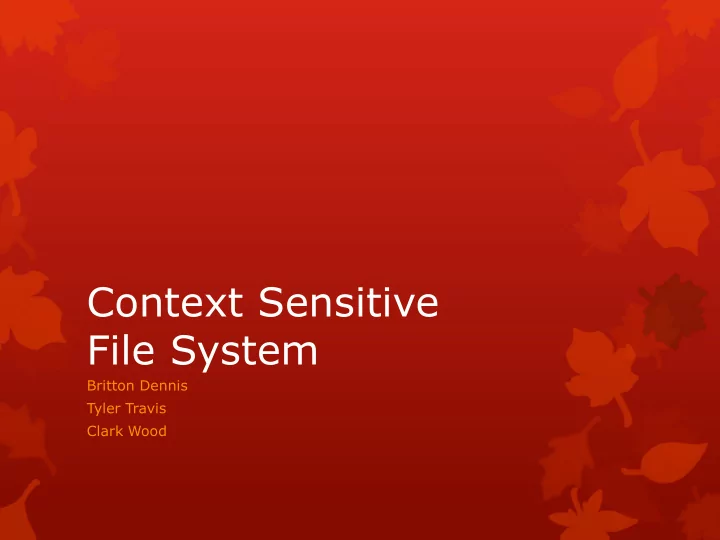

Context Sensitive File System Britton Dennis Tyler Travis Clark Wood
Outline Motivation Related Works System Overview Context Monitor File System Demo Problems / Future Work Q and A
Motivation Context awareness is important: Mobile devices, BYOD Cheap Storage Ubiquitous wireless connections Ways related works fall short: Security Transparency
Outline Motivation Related Works System Overview Context Monitor File System Demo Problems / Future Work Q and A
Related Works quFiles Ext3cow NCryptfs
Related Works quFiles Way to implement context awareness at file level quFiles directory stores different versions of the same logical file; serves appropriate file to application on demand Transparent to applications Not transparent to users
Related Works ext3cow Way of doing file versioning / auditing by using copy on write on the inode structure Appends snapshot epoch number to files Semi transparent to applications Not transparent to users
Related Works NCryptfs Adds encryption to existing Linux file systems Balanced security, performance, convenience, portability Prevent clear text from being cached Context unaware
Outline Motivation Related Works System Overview Context Monitor File System Demo Problems / Future Work Q and A
System Overview Proposed by Michael Mitchell Our system is a proof of concept Two components Context Monitor File system Serves different files based on the security of the environment The metrics we wanted to optimize were portability and security
System Diagram User Application Context e.g. Word Monitor User Kernel VFS Modified ext3
Outline Motivation Related Works System Overview Context Monitor File System Demo Problems / Future Work Q and A
Context Monitor Modular user level deamon built mostly in python Each module polls a specific system internal (e.g. USB, Wifi, etc) for the current status The module then calculates how secure that component is at the moment and assigns a number Then all the numbers from all the modules are weighted according to the user’s policy and a general ‘security level’ is generated This is then sent to the file system so that the file system knows whether to open ‘up’ or lock ‘down’ the file access The information is passed down through ioctl calls to give an extra level of security and flexibility as opposed to syscalls or procfiles as the caller needs to know the call number and the magic number
Context Monitor FS Main Flow Context Monitor USB Port Wireless GPS … Test Test Test Test Context Analyzer
Context Monitor Test Case Flow Context Monitor USB Test USB Module USB USB USB Level Level Level … 0 1 n USB Calculator
Outline Motivation Related Works System Overview Context Monitor File System Demo Problems / Future Work Q and A
File System Built from ext3 from kernel v3.8.5 For each file the user sees there are really n+1 files where n is the number of security levels The extra n files have the same base name put append a separator string as well as the security level number To keep secure data from being leaked, during a security level change, the file system will close all processes (as well as their children) that opened a file owned by the file system To prevent name space collisions and secure information leakage, the read directory file operation will hide all files ending with our suffix (except the ones the user created which can be determined through a recursive scan) To offer more data at higher security levels, the inode from the file at level i has blocks that point to all the blocks that inode at i-1 points to as well as some blocks only it can see.
File System Organization Foo.txt Physical File File File Block Foo.txt Foo.txt:0 Foo.txt:1 300 Physical Block 301 Dummy Level 0 Level 1 inode inode inode Physical Block 302 Physical Block 303
Outline Motivation Related Works System Overview Context Monitor File System Demo Problems / Future Work Q and A
Demo
Outline Motivation Related Works System Overview Context Monitor File System Demo Problems / Future Work Q and A
Problems / Future Work File system Get write to work Try to eliminate the need to open/close files in kernel context Fairly high chance that code contains locking issues and memory leaks Run some benchmarks and get some performance numbers to see if this is even within in the realm of usability Look into possible caching issues Resolve naming collisions that occur from non regular files Support other file operations Add similar mechanism for other types of files, e.g.. Directories Add support for an arbitrarily large number of different security levels Context Monitor Add other tests Close file system if security level goes below acceptable limits Add config options Provide a second user level program Allow users to view data blocks belonging only at a certain levels Allow users to switch to a level lower than what is deemed safe
Outline Motivation Related Works System Overview Context Monitor File System Demo Problems / Future Work Q and A
Q and A
Recommend
More recommend